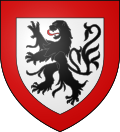Wolfisheim Office
The Wolfisheim office was an office of the Lichtenberg rule , from 1480 the County of Hanau-Lichtenberg , from which it passed to the Landgraviate of Hesse-Darmstadt in 1736 .
history
The internal official organization of the Lichtenberg rule came into being at the end of the 13th century. Anna von Lichtenberg (* 1442; † 1474), one of the two heirlooms of Ludwig V von Lichtenberg (* 1417; † 1474) married Count Philip I the Elder of Hanau-Babenhausen (* 1417; † 1480), one of them had received a small secondary school from the inventory of the County of Hanau in order to be able to get married. The county of Hanau-Lichtenberg came into being through the marriage. After the death of the last Lichtenberger, Jakob von Lichtenberg , an uncle of Anna, Philipp I. d. Ä. In 1480 half of the Lichtenberg rule , including the small Wolfisheim office.
With the reunion policy of France under King Louis XIV , the Wolfisheim office came under French sovereignty. After the death of the last Hanau count, Johann Reinhard III. In 1736, the inheritance - and with it the Wolfisheim office - fell to the son of his only daughter, Charlotte , the hereditary prince and later Landgrave Ludwig (IX) of Hesse-Darmstadt . With the upheaval started by the French Revolution , the Wolfisheim office became part of France and was dissolved in the subsequent administrative reforms.
According to a census from May 1798, the office had 3,112 inhabitants.
Components
Associated places
| place | origin | Law | annotation |
|---|---|---|---|
| Bolsenheim (castle) | Only documented as an inventory of the office in Hesse-Darmstadt times. | ||
| Ehnwihr (Married Weier) | Bought by the landgraves in Alsace? | Fief to the von Ratsamhausen | Since all of the fiefdoms were granted, only fiefdom remained at Hanau-Lichtenberg, so that the castle was only formally part of the office or not at all. |
| Eschau | Bought by the landgraves in Alsace? | Fief to the von Ratsamhausen | Since the village and bailiwick were all fiefdoms, only fiefdom remained with Hanau-Lichtenberg, so that the place was only formally part of the office. |
| Fegersheim | |||
| Hangenbieten (village and mill) | Allod | Awarded to the Beger von Geispolsheim , so that the place was only formally part of the office. | |
| Knebelsburg Castle | |||
| Muttersholtz (Muttersholz, Müttersholz, Mintersholz) | Bought by the landgraves in Alsace? | Fief to the von Ratsamhausen | Since the village and bailiwick were all fiefdoms, only fiefdom remained with Hanau-Lichtenberg, so that the place was only formally part of the office. |
| Ohnenheim | |||
| Thaff Zell | |||
| Treipertsweiher | |||
| Wiebolsheim | Was probably in the area of Eschau | ||
| Wolfisheim (place, castle and mill) | Proven to have been in Lichtenberg possession since 1271, finally to Lichtenberg in 1463. | Fief of the Bishop of Metz |
Other ingredients
- Rights in Achenheim
- Donations from Breuschwickersheim , as a fiefdom of the Bishop of Strasbourg .
- Rights in Ergersheim
- Dinghof zu Osthofen , which came from the Marschalktum Hüneburg, a fiefdom of the Bishop of Strasbourg, and was further lent to the von Matzenheim .
literature
- Fritz Eyer: The territory of the Lords of Lichtenberg 1202-1480. Investigations into the property, the rule and the politics of domestic power of a noble family from the Upper Rhine . In: Writings of the Erwin von Steinbach Foundation . 2nd edition, unchanged in the text, by an introduction extended reprint of the Strasbourg edition, Rhenus-Verlag, 1938. Volume 10 . Pfaehler, Bad Neustadt an der Saale 1985, ISBN 3-922923-31-3 (268 pages).
- Friedrich Knöpp: Territorial holdings of the County of Hanau-Lichtenberg in Hesse-Darmstadt . [typewritten] Darmstadt 1962. [Available in the Hessisches Staatsarchiv Darmstadt , signature: N 282/6].
- Alfred Matt: Bailliages, prévôté et fiefs ayant fait partie de la Seigneurie de Lichtenberg, du Comté de Hanau-Lichtenberg, du Landgraviat de Hesse-Darmstadt . In: Société d'Histoire et d'Archaeologie de Saverne et Environs (Eds.): Cinquième centenaire de la création du Comté de Hanau-Lichtenberg 1480 - 1980 = Pays d'Alsace 111/112 (2, 3/1980), p 7-9.
Remarks
- ↑ Knöpp, p. 20, himself has doubts about the correct spelling of the name.
Individual evidence
- ^ Matt, p. 9.
- ↑ Knöpp, p. 20.
- ↑ Knöpp, p. 20.
- ↑ Knöpp, p. 20.
- ↑ Eyer, p. 179.
- ↑ Eyer, p. 208.
- ↑ Eyer, p. 179.
- ↑ Eyer, pp. 233f.
- ↑ Knöpp, p. 20.
- ↑ Eyer, p. 179.
- ↑ Eyer, p. 208.
- ↑ Eyer, pp. 233f.
- ↑ Knöpp, p. 20.
- ↑ Eyer, p. 239.
- ↑ Eyer, p. 111.
- ↑ Eyer, pp. 112, 181.
- ↑ Eyer, p. 234.
- ↑ Knöpp, p. 20.
- ↑ Knöpp, p. 20.
- ↑ Eyer, p. 179.
- ↑ Eyer, p. 208.
- ↑ Eyer, pp. 233f.
- ↑ Knöpp, p. 20.
- ↑ Knöpp, p. 20.
- ↑ Knöpp, p. 20.
- ↑ Knöpp, p. 20.
- ↑ See: Matt, p. 9.
- ↑ Eyer, p. 239.
- ↑ Eyer, p. 54, note 22.
- ↑ Eyer, p. 75.
- ↑ Knöpp, p. 19; Eyer, p. 160.
- ↑ Eyer, p. 239.
- ↑ Eyer, pp. 141, 239.
- ↑ Eyer, p. 141.
- ↑ Eyer, p. 239.
- ↑ Eyer, pp. 141, 153, 239.
- ↑ Eyer, p. 202.


